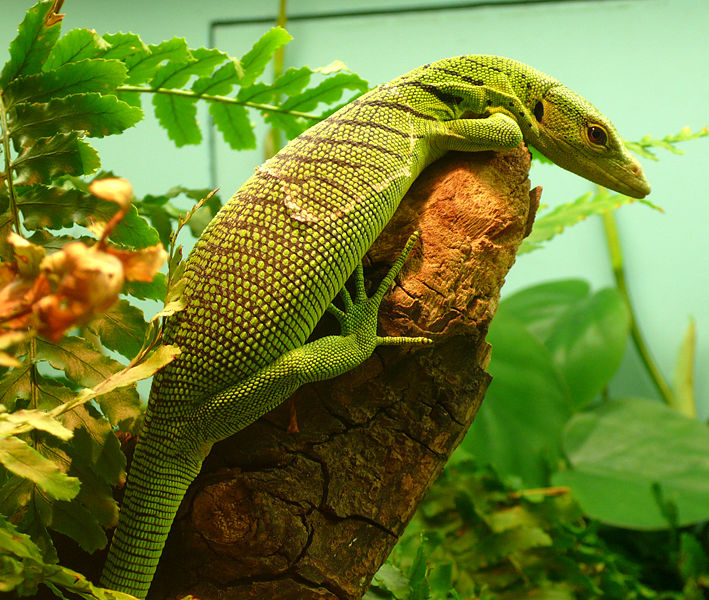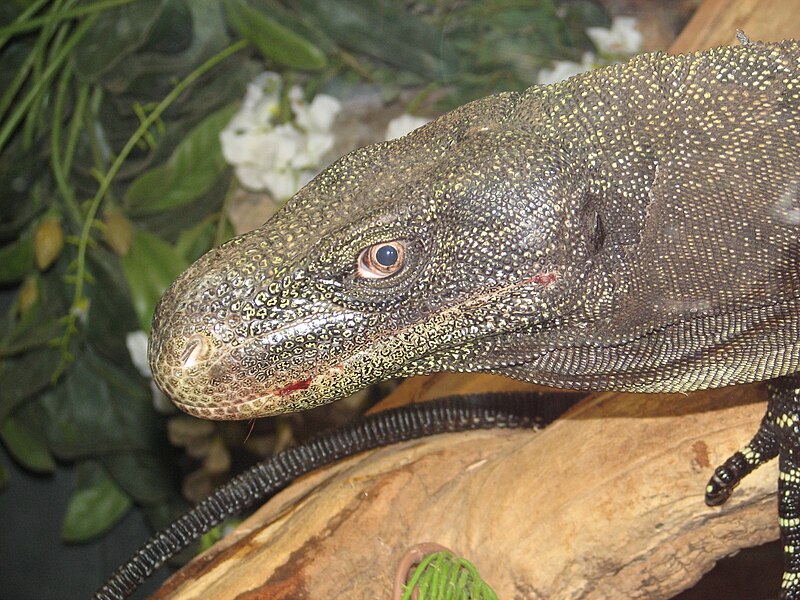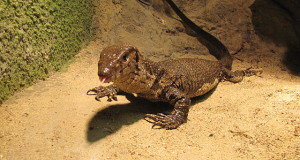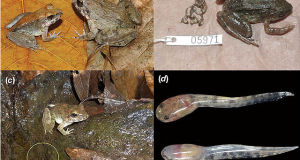
It’s well-known that the world still hides countless “undiscovered” animals and plants – even Central Park in NYC recently yielded a previously unknown centipede. However, it is still something of a surprise when large, colorful creatures remain unseen into modern times. Such is the case for the Northern Sierra Madre Forest Monitor (Varanus bitatawa), a spectacularly colored, 6-foot-long lizard that has been designated as a new species in the current (April, 2010) issue of the journal Biology Letters.
Large, Colorful and Unique
The new species, found only in the northern Philippines (Aurora and Isabella Provinces, northern Luzon), has generated awe among lizard enthusiasts – not only for its large size and brilliant black-and-yellow coloration, but also because of a lifestyle that is quite rare among monitor lizards – it is an arboreal fruit eater.
The few other known arboreal monitors are carnivorous and, with the exception of the Crocodile Monitor (V. salvadorii, see photo), are quite small and slender (i.e. the Green Tree Monitor, see photo). The massive Forest Monitor reaches at least 22 pounds in weight. Its diet, as far as is known, consists of Pandanus and Pili Nut Fruits, figs and, possibly, snails.
History: Documenting a New Species
The lizard is only “new” to herpetologists – it has long been hunted for food by the Agta and IIogot people, and, in fact, is found near heavily populated areas. The first known photo of one popped up in 2001, but it was not until 2003 that it attracted serious investigation; an actual specimen eluded biologists until 2009.
Biologists from the Natural History Museum of the Philippines and the University of Kansas (an institution long on the forefront of herpetological research) collaborated to uncover and describe the spectacular creature.
Monitor Diversity
The Northern Sierra Madre Forest Monitor is the third frugivorous monitor lizard to be discovered in the Philippines – these are the only members of the family Varanidae  that are not predominantly carnivorous. The Gray’s Monitor or Butaan (V. olivaceus), to which the Forest Monitor may be related, was first recorded in 1845 but was not seen by herpetologists until the mid-1970’s. The other fruit-eater, the Mabitang (V. mabitang) was not officially recognized until 2001. All are believed threatened by logging, mining, deforestation and, possibly, hunting.
that are not predominantly carnivorous. The Gray’s Monitor or Butaan (V. olivaceus), to which the Forest Monitor may be related, was first recorded in 1845 but was not seen by herpetologists until the mid-1970’s. The other fruit-eater, the Mabitang (V. mabitang) was not officially recognized until 2001. All are believed threatened by logging, mining, deforestation and, possibly, hunting.
The discovery of the Forest Monitor brings to 70 the number of monitor lizard species described thus far. Ranging across Asia, Africa and Australia, they are generally associated with warm climates, but the Desert Monitor, (V. griseus) may be found as far north as Kazakhstan. At 8 inches long, the Short-tailed Monitor (V. brevicauda), is the smallest of the group…the Komodo dragon (V. komodoensis), the world’s largest lizard, occasionally tops 10 feet in length.
Keep Looking!
That such a large, active lizard could remain in relative obscurity for so long fuels the imaginations of those (such as I!) who believe that there are a great many wondrous creatures remaining to be found. Rumors persist in New Guinea of a 20-foot-long tree-dwelling lizard dubbed the “Papuan Dragon” – given the inaccessibility of its presumed rainforest habitat, who knows…?
Further Reading
I had the good fortune to work with Crocodile Monitors, another giant arboreal species; please see This Article for details.
This Mampan Conservation article details the quest to find the Forest Monitor; the only known video of it can be found there as well.
Crocodile Monitor image referenced from wikipedia and originally posted by Lt Shears
 That Reptile Blog – Reptile, Amphibian and Exotic Pet Care and Information
That Reptile Blog – Reptile, Amphibian and Exotic Pet Care and Information




i love green color 🙂
Hello, Frank Indiviglio here.
Thanks for your interest in our blog. I agree…very rare to see such a vivid green in a lizard. I look forward to your future comments,
Best regards, Frank Indiviglio.
If a monitor lizard 20 feet long does exist in New Guinea then it wouldn’t spend any of its time in the tress it would simply be to heavy so it would be a ground dwelling reptile. I suspect that in such a area where even scientists call it the lost world I suspect a huge 20 foot long carnivorous lizard may very well be one of history’s next big discoveries. new Guinea is also reportedly home to a flying reptile called the ropen which is said to look extremely similar to a pterosaur so if there are flying reptiles and dinosaur like lizards here New Guinea would certainly go down i history as Conan Doyle’s Real Lost World
Hello Antonio, Frank Indiviglio here.
Thanks for the feedback. I’d say the animals actually in existence in New Guinea render it something of a lost world already! An ornithologist colleague of mine spent 3 years there on research, and stunned me with his observations.
As for arboreal giants, it’s hard to predict; some huge mammals rarely come to ground, but of course they have adaptations to allow for that; the vast differences in the builds/weights of Crocodile as compared to Komodo Monitors suggest that quite a but is possible even given the same general body plan – hard to put anything past evolution!
Well, they filmed and then caught a giant squid, so you never know – let’s hope we find out,
Good luck and please keep me posted.
Best regards, Frank Indiviglio.
Come and see for yourself a large flesh eating/carnivorous lizard on the western part of Papua New Guinea.
I have been looking for info on this lizard on the web but there is basically no information at all on this lizard. Shows there is no research on it.
A good subject for research but make sure you don’t get caught by it before you finish your paper.
Check it out!
Hi,
Thanks …yes, many stories, also speculation as to how large the Crocodile Monitor gets; please see here...well, if there’s giants out there, no better place to look than PNG – I only wish research funds were easier to come by! best, Frank